A TransLink trolley visits Seattle
A TransLink trolley visits Seattle
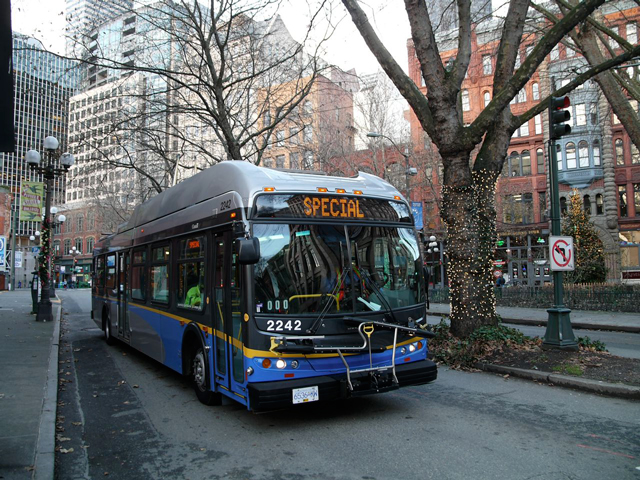
One of our trolley buses went a little off its regular route last week—it was roaming the streets of Seattle for a day!
That’s because we were demonstrating new trolley technology for the King County Metro Transit agency in the Seattle area. Two staff from the Coast Mountain Bus Company showcased the bus and fielded technical questions for the Seattle agency. (And if you’re curious: the trolley went down by flat-bed truck and Metro Transit covered all costs. Sadly, there’s no trolley wire between here and Seattle!)
Anyway, just thought you’d enjoy seeing how our region shares knowledge on transit solutions :) You can also check out Seattle Transit Blog for their notes on the trolley trial, with video and way more photos.
Thanks to Klaus Peter Canavan from Vossloh for sending through the photo above as well—read on to see a few more of Klaus’s trolley photos below.
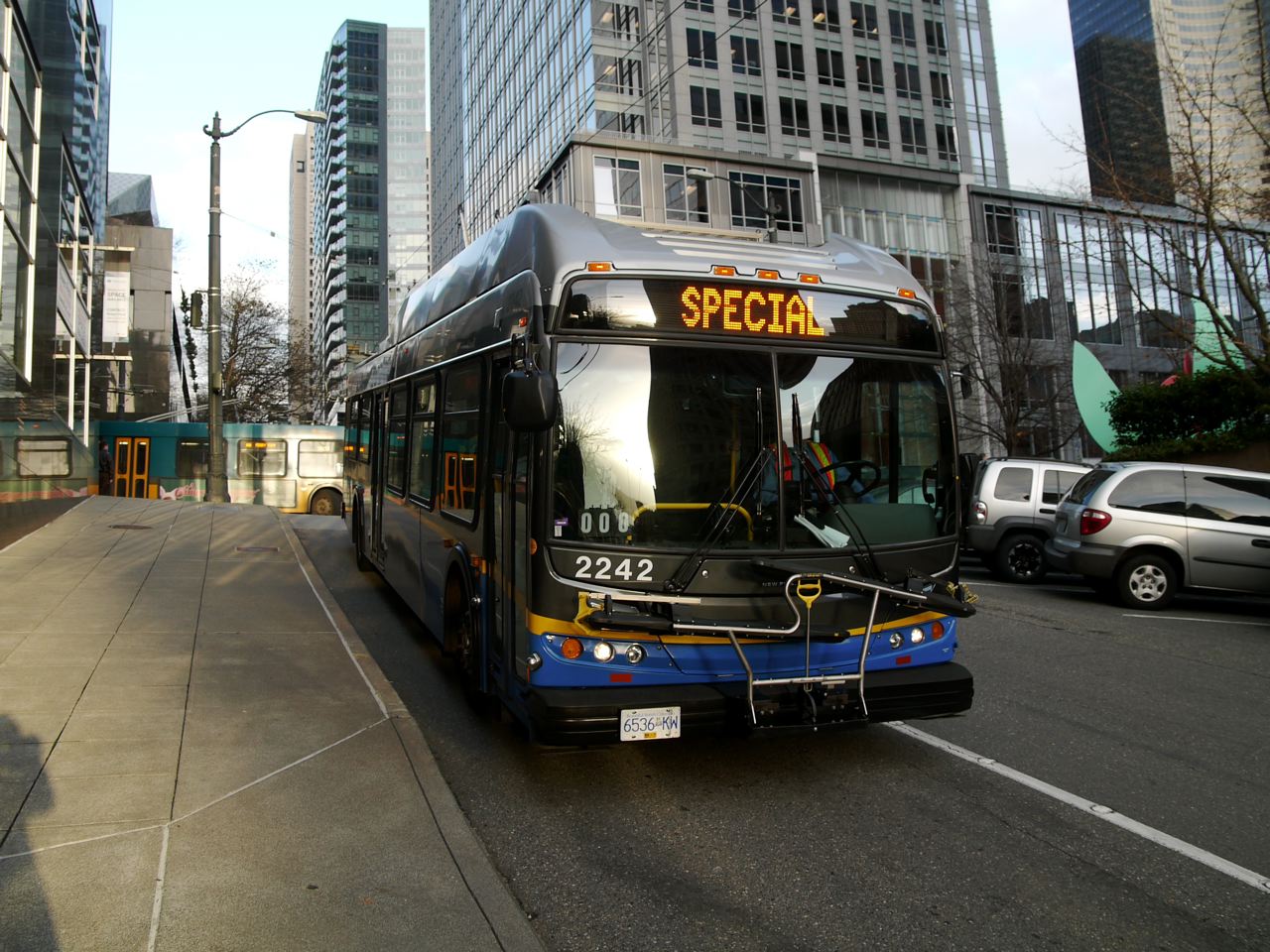
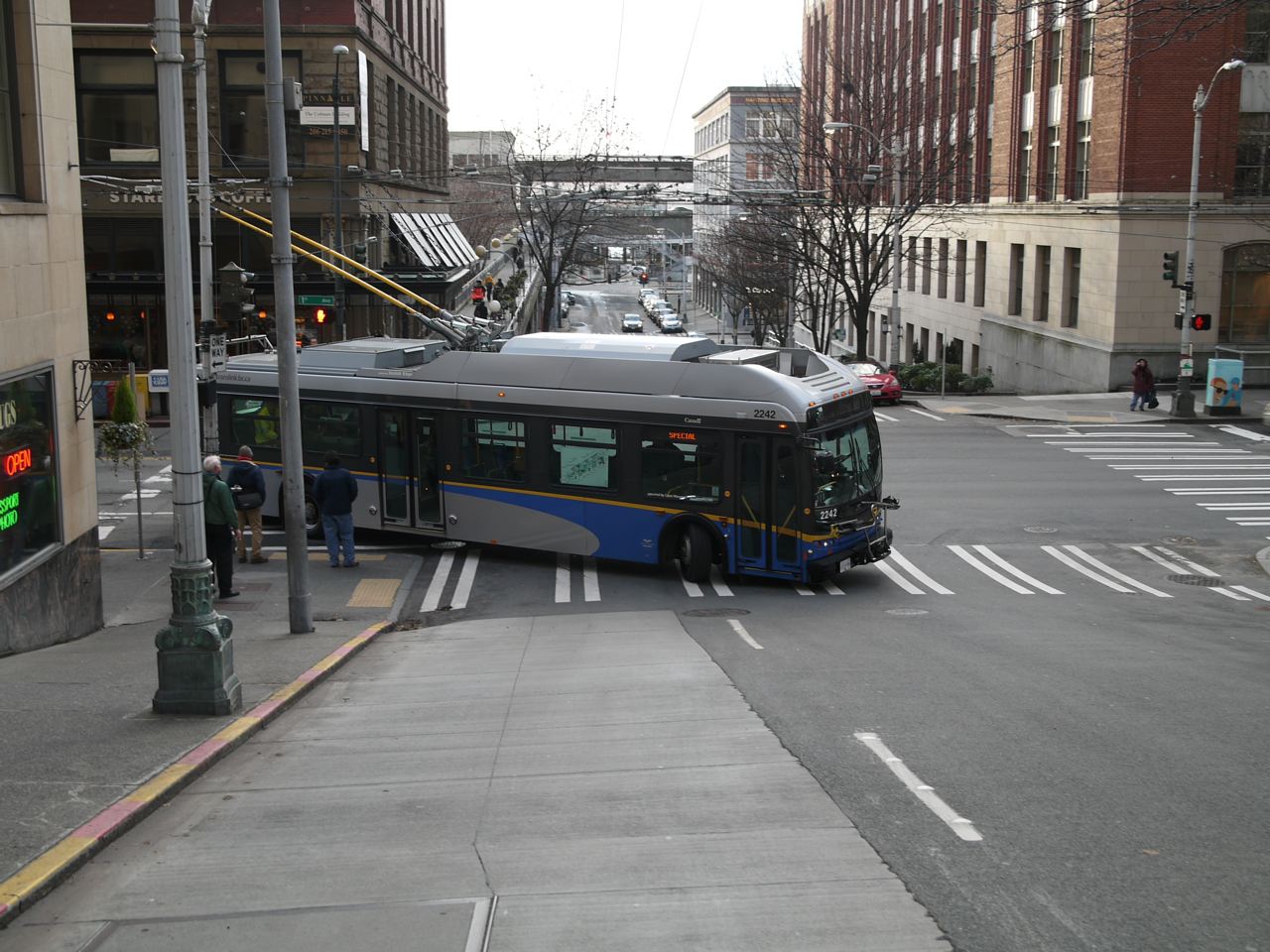
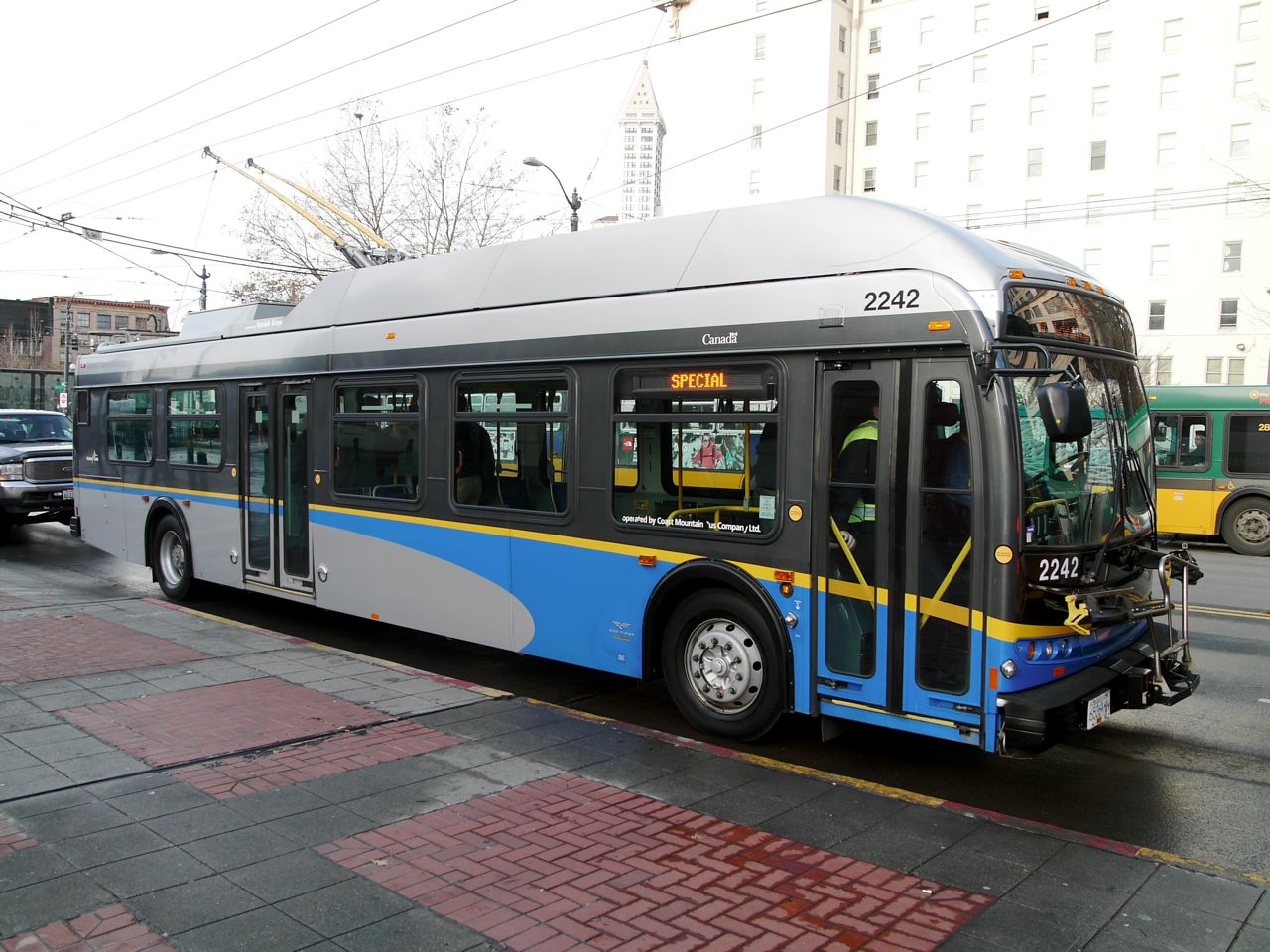
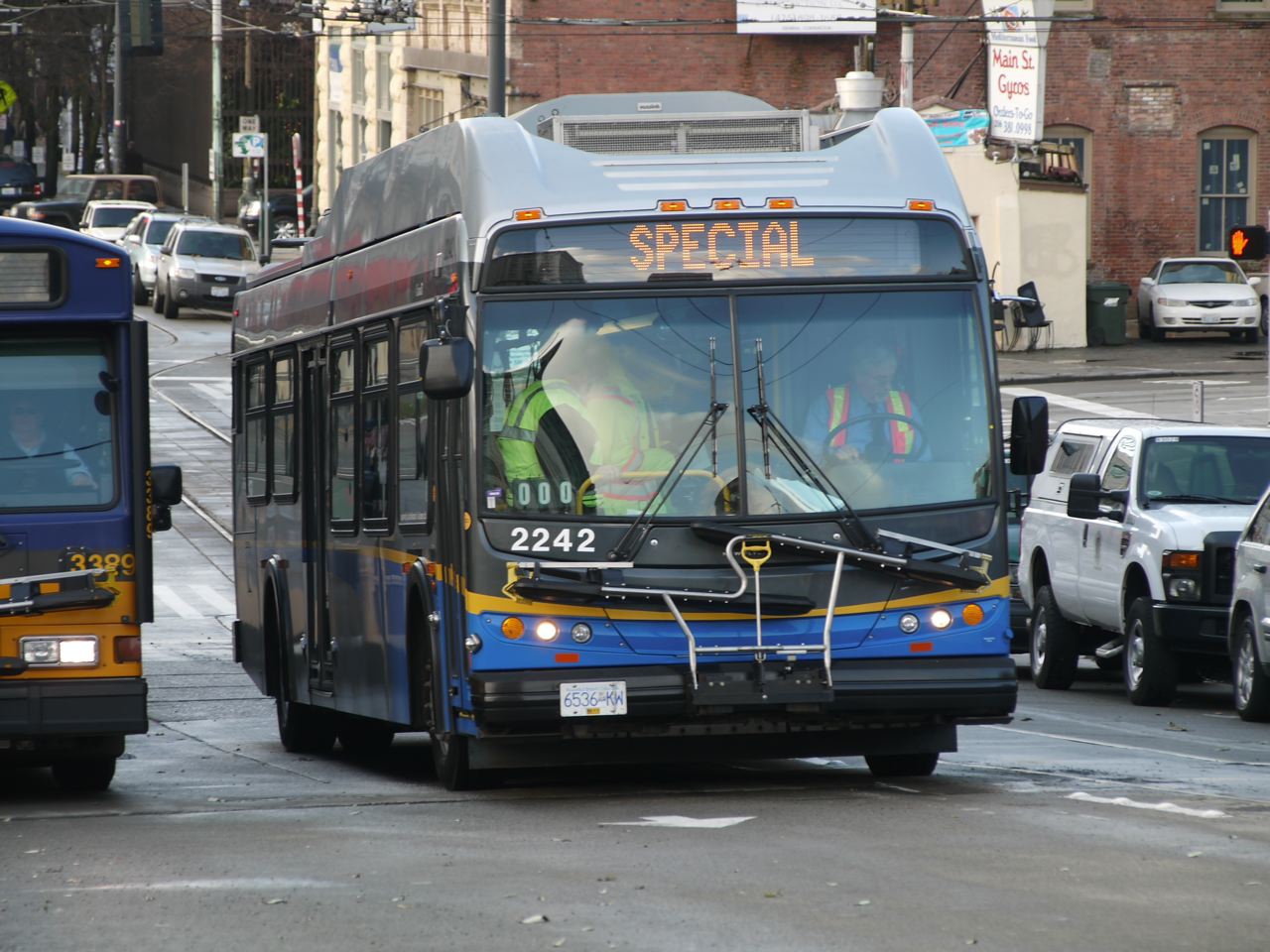






interesting! looks like “Vanna” is doing a country tour! :P
Cool! So is the electrical and physical infrastructure (voltage, spacing of wires, etc.) the same in Seattle as it is here? Is that due to convenient coincidence, or is there some kind of “world standard” for trolley wires?
b
ben K: From the King County Metro FAQ about the trolley evaluation project, it seems that the physical infrastructure is slightly different—700V vs 600V here etc—but judging by the trial, the bus was able to accommodate those differences.
I don’t know if there is a world standard for trolley wires! Can anyone out there throw in some insight on that question?
“new trolley technology”? What is it that they don’t already have specifically?
Henry: check the King County trolley evaluation project page for more info. It just sounds like their trolleys are coming to the end of their normal lives and they are looking for replacements.
[…] This post was mentioned on Twitter by Breaking News in Van, iSkytrain. iSkytrain said: A TransLink trolley visits Seattle http://ff.im/-vbcpz […]
I suspect trolleybuses, especially newer models, can accept a range of voltages. I wonder if it’s automatic or if a switch needs to be turned to enable the change.
On a slightly different topic, can I be correct in assuming the reason why the 8 Fraser is short turning at 49th and using a diesel shuttle the rest of the way is because driving the buses off grid is hard on the battery?
Cliff: as far as I know the battery is for emergencies only and can’t actually power the bus for longer distances. On the Seattle Transit Blog post, they mention that the bus could go about 8 blocks using 75% of the battery’s charge—so maybe the route past 49th is just too much distance for the battery! A diesel shuttle very likely provides better reliability.
I think we should call that bus “Vanna! The Adventurer!” :D
Wow, that isn’t long at all. I was under the impression they could travel a good 10 or 15 minutes off the wires at a VERY slow speed. But I guess in reality it’s more like 5 or 6 minutes.
Technically speaking, the off grid distance would be from Marine Drive to Kent in both directions. I’m sure there’s still power on the lines down there, but there’s no easy way to turn a bus around without going to Kent. (Unless power is shut down in the vicinity of the sinkhole)
Still, it’s handy to have. I bet they got used when the sinkhole occurred and the buses didn’t have any other way to depart. I recall hearing that not many systems in the world have that luxury.
Here’s one other system that DOES have that luxury: http://poneke.wordpress.com/2010/02/19/batt/
Not only that, they can travel at full speed for five kilometres!
Might it be possible to find out what kind of battery the buses carry? Nothing specific like the brand or anything, just the type. A Google search yielded nothing :(
Great photos and thanks for the mention! The CMBC staff were handing out some transit goodies (trolley pins, pens, notepads), unfortunately, they didn’t have copies of The Buzzer.
Other than the voltage, they had to install equipment to allow the trolley to use our wire switches. Many of our switches are operated by the driver’s turn signals. I also heard of a slight difference in the way the poles “hold” the wire, but they didn’t elaborate on that.
On a sidenote, the second picture of our trolley in Seattle appears to be running without the poles up!
What a coincidence!
If my reaction in Edmonton is the same as those in Seattle, I’m sure there will be dozens of double-takes followed by thoughts of ‘Hey cool bus, how do I get a ride on that!?’
Thanks Translink for letting KC Metro try out one of your ETBs
Oran: No copies of the Buzzer?! I am aghast! :) I can always mail you one if you like.
Cliff: The battery is about 10,000 9-volt batteries all tied together. Just kidding! It’s a nickel-cadmium battery, as Oran reported in his blog post.
My last post meant to say the last picture, not the second.
Thanks for the quick response, Jhen. I was trying to figure out if they were Ni-Cad or Li-Ion. I thought they were probably NiCads but wasn’t sure because they are pretty new and expensive trolleys.
How interesting that the switches in Seattle are operated using the turn signals. This seems far better than how it’s done here, which I recall is done through painted indicators on the pavement telling the driver when to coast through a switch.
Yep. Switching through trolley wires is done the more old-fashioned way here. The painted teardrops tell drivers when to activate the current draw switch on the buses if they want to diverge from the main line (e.g. turning). Once the switch is activated, the bus will increase the amount of current that it’s using, and any switch nearby will sense that and switch to the diverging track.
It is conceivable that we could replace our switches with turn signal controlled switches… but that’s a lot of replacing to do. Besides, most drivers are used to the switches already and I’m not used to hearing a lot of news about defective switches or buses going the wrong way.
Alas, it explains why we saw it on a flatbed coming southbound thru the truck crossing last week. It was quite a sight to see a TransLink bus in the US, especially when the factory is in Canada :)
Oran: Vancouver’s trolleys have the latest Kiepe current collectors; Seattle’s current collectors are the previous generation. Vancouver’s current collectors are lighter and hence will track better, being less susceptible to dewirements caused by the poles whipping.
Allan, the radio induction switch control system used in Seattle is wired into the turn signals, but could just as easily be controlled by a dash toggle switch as when Edmonton still had their trolleys.
The radio induction switch control system requires additional wires between the loop detector (which detects whether to activate the switch or not), a control box mounted on a nearby utility pole, and the switch motors. The current power on/power off system is much cleaner in that regard and works well in Vancouver.
As for coaches increasing their power draw will activate any nearby switch, only the switch that the trolley shoes are passing through will be activated.
LOL it’s the 2242 again!
Aha! I saw that bus on the flatbed too! I wanted to take a photo, but didn’t have enough time to snap the photo! Ah, memories!
Jhenifer: aww thanks! Reading it online works just as well.
What I find interesting is the different approach each took in replacing their trolleys and the timing. Both Seattle’s and Vancouver’s trolley fleet were really old (1979 and 1982) and in need of replacement. Seattle’s “new” trolleys were delivered in 2002. They were new bodies with twenty year old propulsion refitted from the previous generation it replaced. That saved $20 million at the expense of low-floor and battery backup features. Vancouver decided to get brand new trolleys with the latest technology with the first one delivered in 2005, only three years later. However, unlike Vancouver, our old trolleys were already fully accessible (Metro was a pioneer in wheelchair lifts).
Did I miss something? Why is this trolley nicknamed “Vanna”?
Interesting.
The vinyl lettering on the window in this image
http://buzzer.translink.ca/wp-content/uploads/2010/12/L1240367.jpg
says “operated by Coast Mountain Bus Company Ltd.” but all of the other LFR buses say “proudly operated by Coast Mountain Bus Company Ltd.”
Meraki: I think it’s just the available space on the window for the letters. CMBC is certainly still proud to be operating the trolleys :)
2242 was christened “Vanna” by the fine trolley supporters in Edmonton when ETS borrowed her for a year.
Vanna, short for Vancouver of course.
Meraki,
It’s possible the original factory-installed “proudly operated by Coast Mountain Bus Company” was removed during Vanna’s stint in Edmonton, and upon her return a body-shop stock original “operated by Coast Mountain Bus Company” decal was used as a replacement.
Re the world standard for trolleybuses. The first thing is that all systems operate using direct current (DC). Historically, urban systems operated at voltages around 550v DC. There were some interurban systems that operated on 1200v DC. Verona in Italy was interesting. The interurban trolleys operated at 550v in the town centre (there was a separately owned city trolleybus system) then from the city boundary the wires were at 1200v DC. I rode them and you didn’t “notice the join” except that the speed rose to about 80kph!
As for modern systems, there is a slight trend to higher voltages up to 750v. It doesn’t really matter: a higher voltage just means a slightly lower current. As for 2242, all they needed to do is just alter a computer setting.
The standard for trolley wire spacing is two feet.
Let’s hope Seattle gets ther trolleys renewed. Love to see them in their colors. We’re loosing more & more trolleys in the cities. Edmonton got rid of theirs. Vancouver is the only city that has these buses. Translink did celebrated it’s 60 years of trolley buses, but with new technologies in the works, maybe well have an all new Electric Trolleys that can do both poles up and down at the same speed, (Similar to an electric cars.) and not reduce speeds that only go from 5 blocks instead. Remember, Seattle did had the tunnel for electric trolleys & ran them on diesel gas when out of tunnel. Why can’t Translink do the same with Seattle?